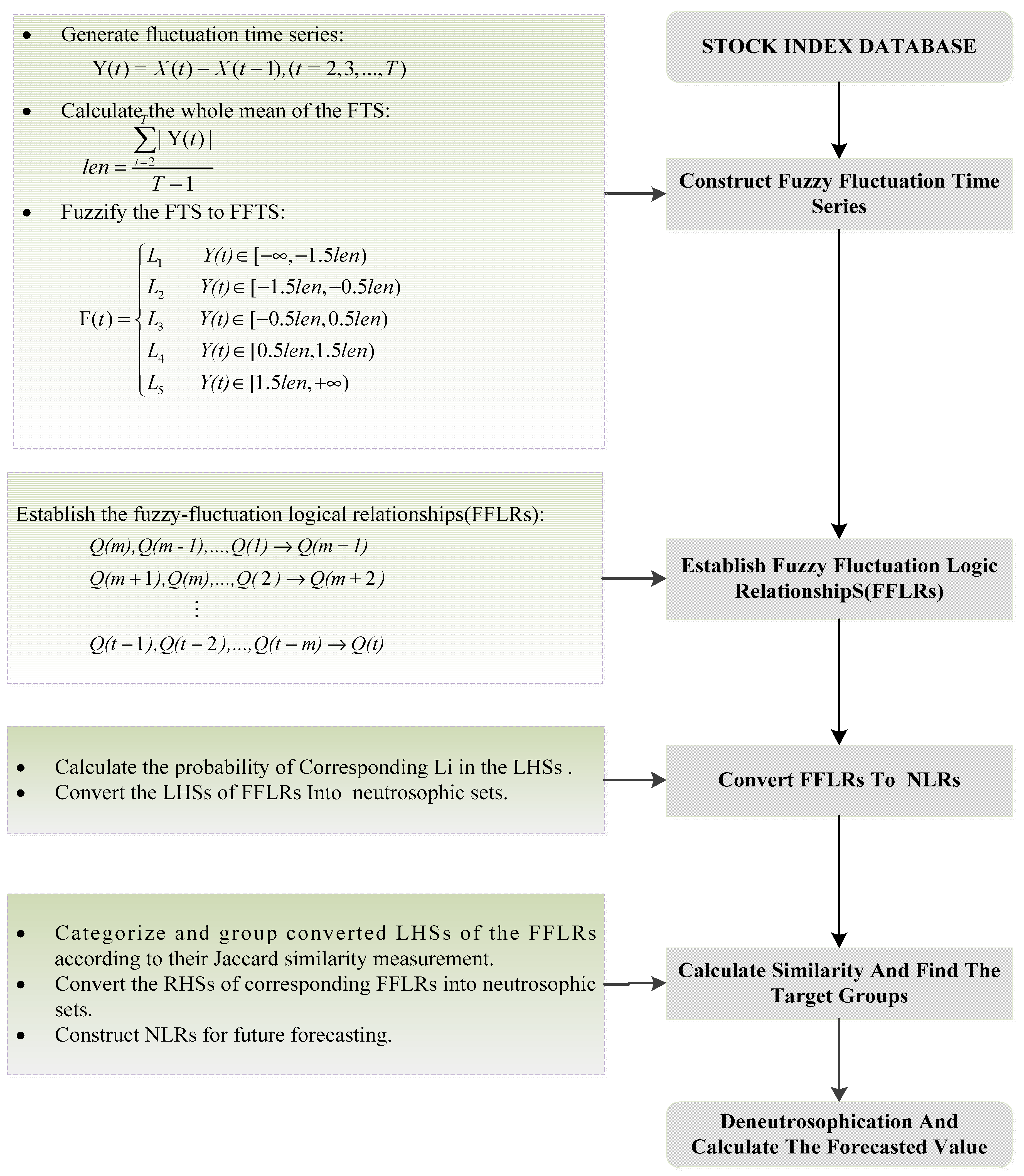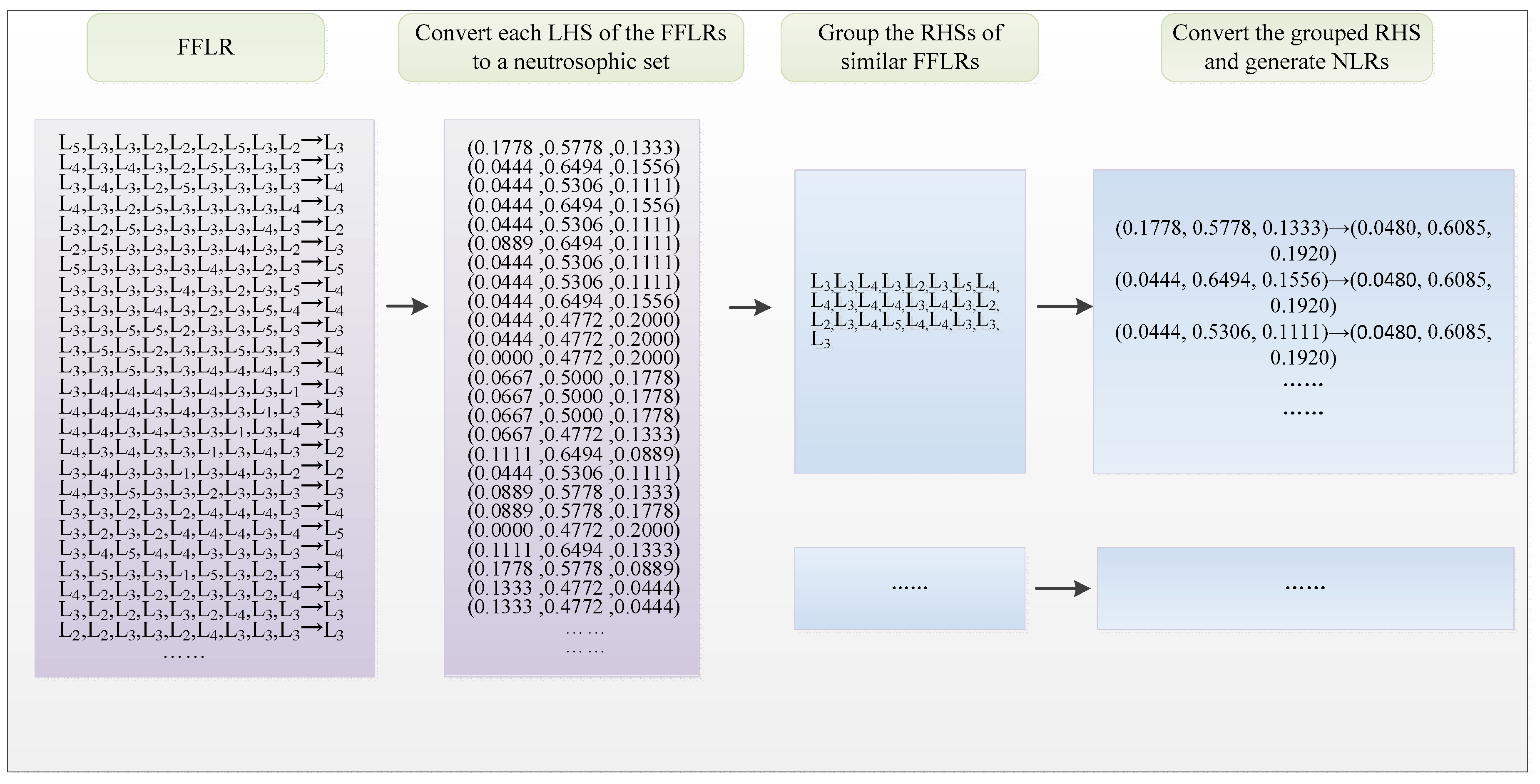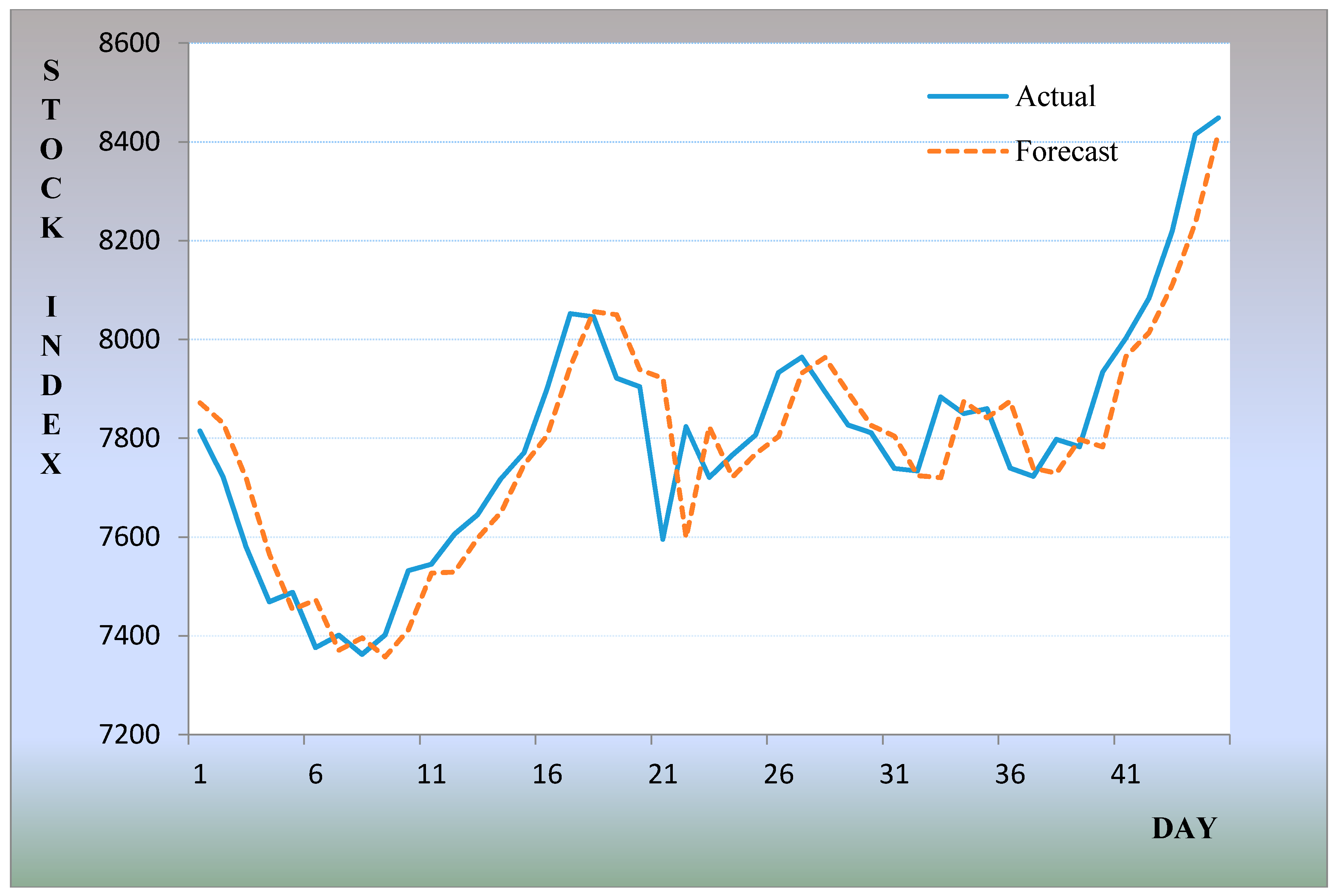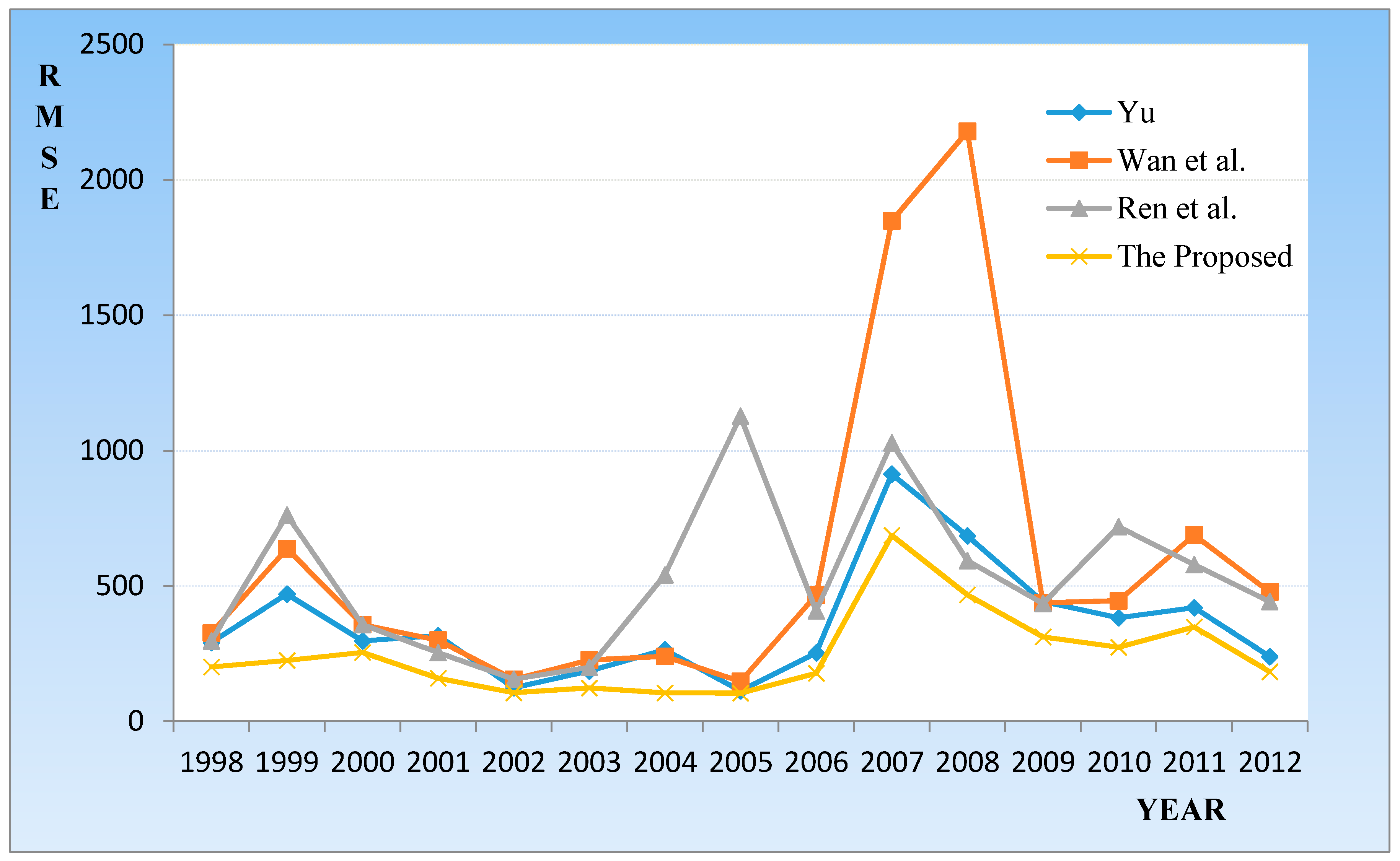A Forecasting Model Based on High-Order Fluctuation Trends and Information Entropy
Abstract
1. Introduction
2. Preliminaries
2.1. Fuzzy Set (FS)
2.2. Fuzzy Time Series (FTS)
2.3. Fuzzy-Fluctuation Time Series (FFTS)
2.4. Information Entropy
2.5. Neutrosophic Set (NS)
2.6. Neutrosophic Logical Relationship (NLR)
2.7. Deneutrosophication of a Neutrosphic Set
3. Proposed Model Based on High-Order Fluctuation Trends and Information Entropy
4. Empirical Analysis
4.1. Forecasting Taiwan Stock Exchange Capitalization Weighted Stock Index (TAIEX)
4.2. Forecasting Hong Kong Heng Seng Index (HIS)
5. Conclusions
Author Contributions
Funding
Conflicts of Interest
References
- Song, Q.; Chissom, B.S. Forecasting enrollments with fuzzy time series—Part I. Fuzzy Sets Syst. 1993, 54, 1–9. [Google Scholar] [CrossRef]
- Song, Q.; Chissom, B.S. Fuzzy time series and its models. Fuzzy Sets Syst. 1993, 54, 269–277. [Google Scholar] [CrossRef]
- Song, Q.; Chissom, B.S. Forecasting enrollments with fuzzy time series—Part II. Fuzzy Sets Syst. 1994, 62, 1–8. [Google Scholar] [CrossRef]
- Pritpal, S.; Gaurav, D. A hybrid fuzzy time series forecasting model based on granular computing and bio-inspired optimization approaches. J. Comput. Sci. 2018, 1877–7503. [Google Scholar]
- Che-Ngoc, H.; Tai, V.V.; Huynh-Le, Q.C.; Ho, V.; Nguyen-Trang, T.; Chu-Thi, M. An Improved Fuzzy Time Series Forecasting Model. Available online: https://www.researchgate.net/publication/321947685/download (accessed on 3 September 2018).
- Guo, H.; Pedrycz, W.; Liu, X. Fuzzy time series forecasting based on axiomatic fuzzy set theory. Neural Comput. Appl. 2018, 3, 1–12. [Google Scholar] [CrossRef]
- Gautam, S.S.; Singh, S.R. A refined method of forecasting based on high-order intuitionistic fuzzy time series data. In Progress in Artificial Intelligence; Springer: Berlin, Germany, 2018; pp. 1–12. [Google Scholar]
- Pannu, H.S.; Tripathi, A. High-order fuzzy time series forecasting model for advance prediction of temperature. In Proceedings of the International Conference on Inventive Computation Technologies, Coimbatore, India, 26–27 August 2016; pp. 1–6. [Google Scholar]
- Lee, L.W.; Wang, L.H.; Chen, S.M.; Leu, Y.-H. Handling forecasting problems based on two-factors high-order fuzzy time series. IEEE Trans. Fuzzy Syst. 2006, 14, 468–477. [Google Scholar] [CrossRef]
- Zhang, Z.; Li, Y.; Jin, S.; Zhang, Z.; Wang, H.; Qi, L.; Zhou, R. Modulation Signal Recognition Based on Information Entropy and Ensemble Learning. Entropy 2018, 20, 198. [Google Scholar] [CrossRef]
- Jiang, Q.; Shen, Y.; Li, H.; Xu, F. New Fault Recognition Method for Rotary Machinery Based on Information Entropy and a Probabilistic Neural Network. Sensors 2018, 18, 337. [Google Scholar] [CrossRef] [PubMed]
- Núñez, J.A.; Cincotta, P.M.; Wachlin, F.C. Information entropy. Celest. Mech. Dyn. Astron. 1996, 64, 43–53. [Google Scholar] [CrossRef]
- Duan, B.; Li, Z.; Gu, P.; Wang, Y.; Wu, J.; Wang, L.; Zou, X.; Liu, J.; Zou, Y.; He, R. Evaluation of battery inconsistency based on information entropy. J. Energy Storage 2018, 16, 160–166. [Google Scholar] [CrossRef]
- Xu, X.H.; Luo, X. Information entropy risk measure applied to large group decision-making method. Soft Comput. 2018, 1–11. [Google Scholar] [CrossRef]
- Wang, W.; Wang, D.; Singh, V.P.; Wang, Y.; Wu, J.; Wang, L.; Zou, X.; Liu, J.; Zou, Y.; He, R. Optimization of rainfall networks using information entropy and temporal variability analysis. J. Hydrol. 2018, 559, 136–155. [Google Scholar] [CrossRef]
- Huo, W.; Huang, Y.; Pei, J.; Zhang, Q.; Gu, Q.; Yang, J. Ship Detection from Ocean SAR Image Based on Local Contrast Variance Weighted Information Entropy. Sensors 2018, 18, 1196. [Google Scholar] [CrossRef] [PubMed]
- Liu, Z.; Shang, P. Generalized information entropy analysis of financial time series. Phys. A Stat. Mech. Appl. 2018, 505, 1170–1185. [Google Scholar] [CrossRef]
- Liang, X.; Si, D.; Xu, J. Quantitative Evaluation of the Sustainable Development Capacity of Hydropower in China Based on Information Entropy. Sustainability 2018, 10, 529. [Google Scholar] [CrossRef]
- Mahdi, O.A.; Pardede, E.; Cao, J. Combination of information entropy and ensemble classification for detecting concept drift in data stream. In Proceedings of the Australasian Computer Science Week Multiconference, Brisband, Queensland, Australia, 29 January–2 February 2018. [Google Scholar] [CrossRef]
- Smarandache, F. A unifying field in logic. In Multiple-Valued Logic; IEEE: Piscataway, NJ, USA, 1999; Volume 8, pp. 489–503. [Google Scholar]
- Wang, H.; Smarandache, F.; Zhang, Y.Q.; Sunderraman, R. Single valued neutrosophic sets. Rev. Air Force Acad. 2010, 4, 410–413. [Google Scholar]
- Wang, H.; Smarandache, F.; Zhang, Y.Q.; Sunderraman, R. Interval Neutrosophic Sets and Logic: Theory and Applications in Computing; Hexis: Phoenix, AZ, USA, 2005. [Google Scholar]
- Ye, J. A multicriteria decision-making method using aggregation operators for simplified neutrosophic sets. Intell. Fuzzy Syst. 2014, 26, 2459–2466. [Google Scholar]
- Ye, J.; Cui, W. Exponential Entropy for Simplified Neutrosophic Sets and Its Application in Decision Making. Entropy 2018, 20, 357. [Google Scholar] [CrossRef]
- Abdel-Basset, M.; Mai, M. The Role of Single Valued Neutrosophic Sets and Rough Sets in Smart City: Imperfect and Incomplete Information Systems. Measurement 2018, 124, 47–55. [Google Scholar] [CrossRef]
- Şahin, R.; Liu, P. Correlation coefficient of single-valued neutrosophic hesitant fuzzy sets and its applications in decision making. Neural Comput. Appl. 2017, 28, 1387–1395. [Google Scholar] [CrossRef]
- Van, L.H.; Yu, V.F.; Dat, L.Q.; Dung, C.C.; Chou, S.; Loc, N.V. New Integrated Quality Function Deployment Approach Based on Interval Neutrosophic Set for Green Supplier Evaluation and Selection. Sustainability 2018, 10, 838. [Google Scholar] [CrossRef]
- Wu, H.; Yuan, Y.; Wei, L.; Pei, L. On entropy, similarity measure and cross-entropy of single-valued neutrosophic sets and their application in multi-attribute decision making. In Soft Computing; Springer: Berlin, Germany, 2018. [Google Scholar]
- Uluçay, V.; Deli, I.; Şahin, M. Similarity measures of bipolar neutrosophic sets and their application to multiple criteria decision making. Neural Comput. Appl. 2018, 29, 739–748. [Google Scholar] [CrossRef]
- Ye, J.; Du, S. Some distances, similarity and entropy measures for interval-valued neutrosophic sets and their relationship. Int. J. Mach. Learn. Cybern. 2017. [Google Scholar] [CrossRef]
- Bucolo, M.; Fazzino, S.; Rosa, M.L.; Fortuna, L. Small-world networks of fuzzy chaotic oscillators. Chaos Solitons Fractals 2003, 17, 557–565. [Google Scholar] [CrossRef]
- Zadeh, L.A. The Concept of a Linguistic Variable and its Application to Approximate Reasoning. Inf. Sci. 1974, 8, 199–249. [Google Scholar] [CrossRef]
- Herrera, F.; Herrera-Viedma, E.; Verdegay, J.L. A model of consensus in group decision making under linguistic assessments. Fuzzy Sets Syst. 1996, 79, 73–87. [Google Scholar] [CrossRef]
- Fu, J.; Ye, J. Simplified neutrosophic exponential similarity measures for the initial evaluation/diagnosis of benign prostatic hyperplasia symptoms. Symmetry 2017, 9, 154. [Google Scholar] [CrossRef]
- Ali, M.; Minh, N.V.; Le, H.S. A Neutrosophic Recommender System for Medical Diagnosis Based on Algebraic Neutrosophic Measures. Appl. Soft Comput. 2017. [Google Scholar] [CrossRef]
- Chen, S.M.; Chang, Y.C. Multi-variable fuzzy forecasting based on fuzzy clustering and fuzzy rule interpolation techniques. Inf. Sci. 2010, 180, 4772–4783. [Google Scholar] [CrossRef]
- Chen, S.M.; Chen, C.D. TAIEX Forecasting Based on Fuzzy Time Series and Fuzzy Variation Groups. IEEE Trans. Fuzzy Syst. 2011, 19, 1–12. [Google Scholar] [CrossRef]
- Chen, S.M.; Manalu, G.M.; Pan, J.S.; Liu, H.C. Fuzzy Forecasting Based on Two-Factors Second-Order Fuzzy-Trend Logical Relationship Groups and Particle Swarm Optimization Techniques. IEEE Trans. Cybern. 2013, 43, 1102–1117. [Google Scholar] [CrossRef] [PubMed]
- Cheng, S.H.; Chen, S.M.; Jian, W.S. Fuzzy time series forecasting based on fuzzy logical relationships and similarity measures. Inf. Sci. 2016, 327, 272–287. [Google Scholar] [CrossRef]
- Guan, S.; Zhao, A. A Two-Factor Autoregressive Moving Average Model Based on Fuzzy Fluctuation Logical Relationships. Symmetry 2017, 9, 207. [Google Scholar] [CrossRef]
- Cheng, C.; Yang, J. Fuzzy time-series model based on rough set rule induction for forecasting stock price. Neurocomputing 2018, 302, 33–45. [Google Scholar] [CrossRef]
- Yu, H.K. A refined fuzzy time-series model for forecasting. Phys. A Stat. Mech. Appl. 2005, 346, 657–681. [Google Scholar] [CrossRef]
- Wan, Y.; Si, Y.W. Adaptive neuro fuzzy inference system for chart pattern matching in financial time series. Appl. Soft Comput. 2017, 57, 1–18. [Google Scholar] [CrossRef]
- Ren, Y.; Suganthan, P.N.; Srikanth, N. A Novel Empirical Mode Decomposition with Support Vector Regression for Wind Speed Forecasting. IEEE Trans. Neural Netw. Learn. Syst. 2016, 27, 1793–1798. [Google Scholar] [CrossRef] [PubMed]




| Date (DD/MM/YYYY) | Actual | Forecast | (Forecast − Actual)2 | Date (DD/MM/YYYY) | Actual | Forecast | (Forecast − Actual)2 |
|---|---|---|---|---|---|---|---|
| 1/11/1999 | 7814.89 | 7867.09 | 2724.84 | 1/12/1999 | 7766.20 | 7723.08 | 1859.33 |
| 2/11/1999 | 7721.59 | 7826.66 | 11,039.54 | 2/12/1999 | 7806.26 | 7768.72 | 1408.89 |
| 3/11/1999 | 7580.09 | 7723.14 | 20,462.00 | 3/12/1999 | 7933.17 | 7807.11 | 15,891.12 |
| 4/11/1999 | 7469.23 | 7577.85 | 11,798.99 | 4/12/1999 | 7964.49 | 7932.85 | 1001.33 |
| 5/11/1999 | 7488.26 | 7466.21 | 486.03 | 6/12/1999 | 7894.46 | 7964.17 | 4859.38 |
| 6/11/1999 | 7376.56 | 7485.29 | 11,822.59 | 7/12/1999 | 7827.05 | 7893.82 | 4458.83 |
| 8/11/1999 | 7401.49 | 7370.82 | 940.50 | 8/12/1999 | 7811.02 | 7825.78 | 217.71 |
| 9/11/1999 | 7362.69 | 7395.82 | 1097.82 | 9/12/1999 | 7738.84 | 7810.16 | 5086.43 |
| 10/11/1999 | 7401.81 | 7357.09 | 1999.66 | 10/12/1999 | 7733.77 | 7736.72 | 8.67 |
| 11/11/1999 | 7532.22 | 7404.90 | 16,210.15 | 13/12/1999 | 7883.61 | 7734.83 | 22,134.74 |
| 15/11/1999 | 7545.03 | 7526.69 | 336.36 | 14/12/1999 | 7850.14 | 7882.73 | 1062.35 |
| 16/11/1999 | 7606.20 | 7541.78 | 4149.94 | 15/12/1999 | 7859.89 | 7849.27 | 112.73 |
| 17/11/1999 | 7645.78 | 7606.20 | 1566.58 | 16/12/1999 | 7739.76 | 7868.73 | 16,633.26 |
| 18/11/1999 | 7718.06 | 7653.40 | 4180.83 | 17/12/1999 | 7723.22 | 7747.76 | 602.21 |
| 19/11/1999 | 7770.81 | 7719.84 | 2598.34 | 18/12/1999 | 7797.87 | 7730.15 | 4586.55 |
| 20/11/1999 | 7900.34 | 7784.54 | 13,409.46 | 20/12/1999 | 7782.94 | 7799.05 | 259.55 |
| 22/11/1999 | 8052.31 | 7919.68 | 17,589.44 | 21/12/1999 | 7934.26 | 7784.10 | 22,546.71 |
| 23/11/1999 | 8046.19 | 8058.99 | 163.80 | 22/12/1999 | 8002.76 | 7938.25 | 4161.84 |
| 24/11/1999 | 7921.85 | 8052.64 | 17,105.57 | 23/12/1999 | 8083.49 | 8002.58 | 6546.57 |
| 25/11/1999 | 7904.53 | 7925.99 | 460.58 | 24/12/1999 | 8219.45 | 8084.73 | 18,148.43 |
| 26/11/1999 | 7595.44 | 7908.62 | 98,080.84 | 27/12/1999 | 8415.07 | 8224.42 | 36,348.84 |
| 29/11/1999 | 7823.90 | 7597.74 | 51,147.40 | 28/12/1999 | 8448.84 | 8418.62 | 913.11 |
| 30/11/1999 | 7720.87 | 7823.13 | 10,456.55 | Root Mean Square Error(RMSE) | 102.05 | ||
| m | |||||||||
|---|---|---|---|---|---|---|---|---|---|
| 6 | 7 | 8 | 9 | 10 | 11 | 12 | 13 | 14 | |
| RMSE | 102.76 | 102.52 | 102.2 | 102.05 | 102.61 | 102.89 | 102.9 | 102.88 | 103.4 |
| Method | RMSE | |||||||||
|---|---|---|---|---|---|---|---|---|---|---|
| 1997 | 1998 | 1999 | 2000 | 2001 | 2002 | 2003 | 2004 | 2005 | Average | |
| Chen and Chang [36] | N | N | 123.64 | 131.1 | 115.08 | 73.06 | 66.36 | 60.48 | N | 94.95 |
| Chen and Chen [37] | 140.86 | 144.13 | 119.32 | 129.87 | 123.12 | 71.01 | 65.14 | 61.94 | N | 106.92 |
| Chen et al. [38] | 138.41 | 113.88 | 102.34 | 131.25 | 113.62 | 65.77 | 52.23 | 56.16 | N | 96.71 |
| Cheng et al. [39] | N | N | 100.74 | 125.62 | 113.04 | 62.94 | 51.46 | 54.24 | N | 84.67 |
| Guan et al. [40] | 141.89 | 119.85 | 99.03 | 128.62 | 125.64 | 66.29 | 53.2 | 56.11 | 55.83 | 94.05 |
| Cheng et al. [41] | N | 120.8 | 110.7 | 150.6 | 113.2 | 66.0 | 53.1 | 58.6 | 53.5 | 102.4 |
| Our model | 140.33 | 114.35 | 102.05 | 129.97 | 113.32 | 66.26 | 54.66 | 55.19 | 53.33 | 92.16 |
| Method | 1998 | 1999 | 2000 | 2001 | 2002 | 2003 | 2004 | 2005 | 2006 | 2007 | 2008 | 2009 | 2010 | 2011 | 2012 | Average |
|---|---|---|---|---|---|---|---|---|---|---|---|---|---|---|---|---|
| Yu [42] | 291.4 | 469.6 | 297.05 | 316.85 | 123.7 | 186.16 | 264.34 | 112.4 | 252.44 | 912.67 | 684.9 | 442.64 | 382.06 | 419.67 | 239.11 | 359.66 |
| Wan et al. [43] | 326.62 | 637.1 | 356.7 | 299.43 | 155.09 | 226.38 | 239.63 | 147.2 | 466.24 | 1847.8 | 2179 | 437.24 | 445.41 | 688.04 | 477.34 | 595.26 |
| Ren et al. [44] | 296.67 | 761.9 | 356.81 | 254.07 | 155.4 | 199.58 | 540.19 | 1127 | 407.89 | 1028.7 | 593.8 | 435.18 | 718.33 | 578.7 | 442.44 | 526.46 |
| Our model | 200.72 | 224.81 | 254.56 | 158.88 | 105.53 | 122.99 | 104.51 | 103.66 | 177.49 | 686.79 | 466.81 | 311.76 | 273.49 | 348.57 | 182.85 | 248.23 |
© 2018 by the authors. Licensee MDPI, Basel, Switzerland. This article is an open access article distributed under the terms and conditions of the Creative Commons Attribution (CC BY) license (http://creativecommons.org/licenses/by/4.0/).
Share and Cite
Guan, H.; Dai, Z.; Guan, S.; Zhao, A. A Forecasting Model Based on High-Order Fluctuation Trends and Information Entropy. Entropy 2018, 20, 669. https://doi.org/10.3390/e20090669
Guan H, Dai Z, Guan S, Zhao A. A Forecasting Model Based on High-Order Fluctuation Trends and Information Entropy. Entropy. 2018; 20(9):669. https://doi.org/10.3390/e20090669
Chicago/Turabian StyleGuan, Hongjun, Zongli Dai, Shuang Guan, and Aiwu Zhao. 2018. "A Forecasting Model Based on High-Order Fluctuation Trends and Information Entropy" Entropy 20, no. 9: 669. https://doi.org/10.3390/e20090669
APA StyleGuan, H., Dai, Z., Guan, S., & Zhao, A. (2018). A Forecasting Model Based on High-Order Fluctuation Trends and Information Entropy. Entropy, 20(9), 669. https://doi.org/10.3390/e20090669





